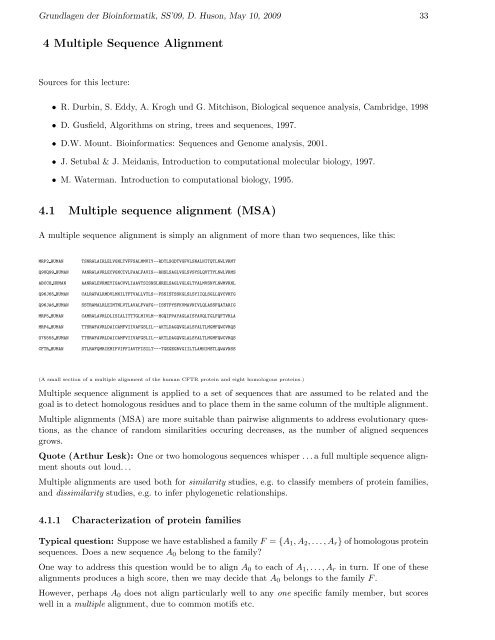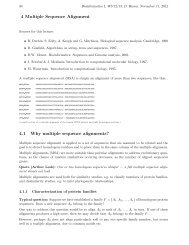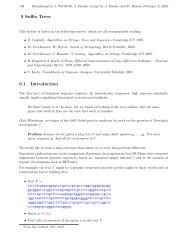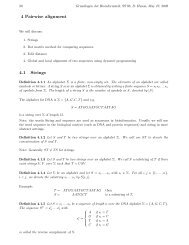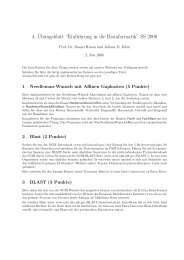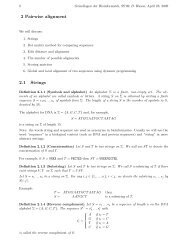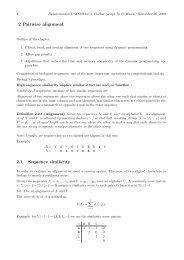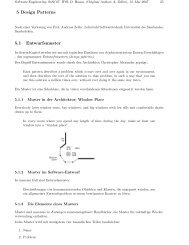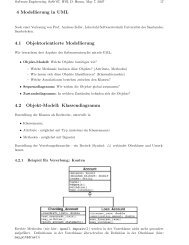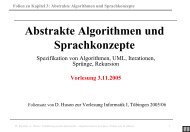4 Multiple Sequence Alignment 4.1 Multiple sequence alignment
4 Multiple Sequence Alignment 4.1 Multiple sequence alignment
4 Multiple Sequence Alignment 4.1 Multiple sequence alignment
Create successful ePaper yourself
Turn your PDF publications into a flip-book with our unique Google optimized e-Paper software.
Grundlagen der Bioinformatik, SS’09, D. Huson, May 10, 2009 334 <strong>Multiple</strong> <strong>Sequence</strong> <strong>Alignment</strong>Sources for this lecture:• R. Durbin, S. Eddy, A. Krogh und G. Mitchison, Biological <strong>sequence</strong> analysis, Cambridge, 1998• D. Gusfield, Algorithms on string, trees and <strong>sequence</strong>s, 1997.• D.W. Mount. Bioinformatics: <strong>Sequence</strong>s and Genome analysis, 2001.• J. Setubal & J. Meidanis, Introduction to computational molecular biology, 1997.• M. Waterman. Introduction to computational biology, 1995.<strong>4.1</strong> <strong>Multiple</strong> <strong>sequence</strong> <strong>alignment</strong> (MSA)A multiple <strong>sequence</strong> <strong>alignment</strong> is simply an <strong>alignment</strong> of more than two <strong>sequence</strong>s, like this:MRP2 HUMANQ9UQ99 HUMANABCC8 HUMANQ96J65 HUMANQ96JA6 HUMANMRP5 HUMANMRP4 HUMANO75555 HUMANCFTR HUMANTSNRWLAIRLELVGNLTVFFSALMMVIY--RDTLSGDTVGFVLSNALNITQTLNWLVRMTVANRWLAVRLECVGNCIVLFAALFAVIS--RHSLSAGLVGLSVSYSLQVTTYLNWLVRMSAANRWLEVRMEYIGACVVLIAAVTSISNSLHRELSAGLVGLGLTYALMVSNYLNWMVRNLCALRWFALRMDVLMNILTFTVALLVTLS--FSSISTSSKGLSLSYIIQLSGLLQVCVRTGSSTRWMALRLEIMTNLVTLAVALFVAFG--ISSTPYSFKVMAVNIVLQLASSFQATARIGCAMRWLAVRLDLISIALITTTGLMIVLM--HGQIPPAYAGLAISYAVQLTGLFQFTVRLATTSRWFAVRLDAICAMFVIIVAFGSLIL--AKTLDAGQVGLALSYALTLMGMFQWCVRQSTTSRWFAVRLDAICAMFVIIVAFGSLIL--AKTLDAGQVGLALSYALTLMGMFQWCVRQSSTLRWFQMRIEMIFVIFFIAVTFISILT---TGEGEGRVGIILTLAMNIMSTLQWAVNSS(A small section of a multiple <strong>alignment</strong> of the human CFTR protein and eight homologous proteins.)<strong>Multiple</strong> <strong>sequence</strong> <strong>alignment</strong> is applied to a set of <strong>sequence</strong>s that are assumed to be related and thegoal is to detect homologous residues and to place them in the same column of the multiple <strong>alignment</strong>.<strong>Multiple</strong> <strong>alignment</strong>s (MSA) are more suitable than pairwise <strong>alignment</strong>s to address evolutionary questions,as the chance of random similarities occuring decreases, as the number of aligned <strong>sequence</strong>sgrows.Quote (Arthur Lesk): One or two homologous <strong>sequence</strong>s whisper . . . a full multiple <strong>sequence</strong> <strong>alignment</strong>shouts out loud. . .<strong>Multiple</strong> <strong>alignment</strong>s are used both for similarity studies, e.g. to classify members of protein families,and dissimilarity studies, e.g. to infer phylogenetic relationships.<strong>4.1</strong>.1 Characterization of protein familiesTypical question: Suppose we have established a family F = {A 1 , A 2 , . . . , A r } of homologous protein<strong>sequence</strong>s. Does a new <strong>sequence</strong> A 0 belong to the family?One way to address this question would be to align A 0 to each of A 1 , . . . , A r in turn. If one of these<strong>alignment</strong>s produces a high score, then we may decide that A 0 belongs to the family F .However, perhaps A 0 does not align particularly well to any one specific family member, but scoreswell in a multiple <strong>alignment</strong>, due to common motifs etc.
34 Grundlagen der Bioinformatik, SS’09, D. Huson, May 10, 2009<strong>4.1</strong>.2 Conservation of structural elementsHere we show the <strong>alignment</strong> of N-acetylglucosamine-binding proteins to the tertiary structure of oneof them:The <strong>alignment</strong> shows exhibits 8 conserved cysteins. These form 4 disulphide bridges, which stabilizethe protein:<strong>4.1</strong>.3 MSA and evolutionary treesOne main application of multiple <strong>sequence</strong> <strong>alignment</strong>s is in phylogenetic analysis. Suppose we aregiven an MSA:A ∗ 1 = N - F L SA ∗ 2 = N - F - SA ∗ 3 = N K Y L SA ∗ 4 = N - Y L SWe would like to reconstruct the evolutionary tree that gave rise to these <strong>sequence</strong>s, e.g.:N Y L S N K Y L S N F S N F L S+K−LN Y L SY to FThe computation of phylogenetic trees will be discussed later.4.2 Definition of an MSASuppose we are given r <strong>sequence</strong>s A i , i = 1, . . . , r over Σ:⎧A 1 = (a 11 , a 12 , . . . , a 1n1 )⎪⎨ A 2 = (a 21 , a 22 , . . . , a 2n2 )A :=.⎪⎩A r = (a r1 , a r2 , . . . , a rnr )
Grundlagen der Bioinformatik, SS’09, D. Huson, May 10, 2009 35Definition 4.2.1 (MSA) A multiple <strong>sequence</strong> <strong>alignment</strong> (MSA) of A is obtained by inserting gaps(’-’) into the original <strong>sequence</strong>s such that all resulting <strong>sequence</strong>s A ∗ i have equal length L ≥ max{n i |i = 1, . . . , r}, A ∗ i = A i after removal of all gaps from A ∗ i , and no column consists of gaps only.Example:A = {apple, paper, pepper}⎧⎫⎨ - a p p l e - ⎬A∗ = p a p - - e r⎩⎭p e p p - e r⎧⎪⎨A ∗ :=⎪⎩A ∗ 1 = (a ∗ 11, a ∗ 12, . . . , a ∗ 1L )A ∗ 2 = (a ∗ 21, a ∗ 22, . . . , a ∗ 2L ).A ∗ r = (a ∗ r1, a ∗ r2, . . . , a ∗ rL ),4.3 Scoring an MSAIn the case of a linear gap penalty, if we assume independence of the different columns of an MSA,then the score α(A ∗ ) of an MSA A ∗ can be defined as a sum of column scores:α(A ∗ ) :=L∑s(a ∗ 1i, a ∗ 2i, . . . , a ∗ ri).i=1Here we assume that s(a ∗ 1i , a∗ 2i , . . . , a∗ ri ) is a function that returns a score for every combination of rsymbols (including the gap symbol).For pairwise <strong>alignment</strong>s there are three types of columns, a match, or a blank in either of the two<strong>sequence</strong>s. The following table shows the 7 possibilities for three <strong>sequence</strong>s:a 1i − a 1i a 1i − − a 1ia 2j a 2j − a 2j − a 2j −a 3k a 3k a 3k − a 3k − −For r <strong>sequence</strong>s, the number of different column types iswhere i is the number of gaps.∑r−1( r= 2i)r − 1i=04.3.1 The sum-of-pairs (SP) scoreHow to define the score s? For two protein <strong>sequence</strong>s, s is usually given by a BLOSUM or PAMmatrix. For more than two <strong>sequence</strong>s, providing such a matrix is not practical, as the number ofpossible combinations is too large.Given an MSA A ∗ , consider two <strong>sequence</strong>s A ∗ p and A ∗ q in the <strong>alignment</strong>. For two aligned symbols uand v we define:⎧⎨ match score for u and v, if u and v are residues,s(u, v) :=−dif either u or v is a gap, or⎩0 if both u and v are gaps.
36 Grundlagen der Bioinformatik, SS’09, D. Huson, May 10, 2009(Note that u = − and v = − can occur simultaneously in a multiple <strong>alignment</strong>.)The multiple <strong>alignment</strong> A ∗ induces a pairwise <strong>alignment</strong> on any two of the input <strong>sequence</strong>s A p andA q .Define the score of this (not necessarily optimal) pairwise <strong>alignment</strong> ass(A ∗ p, A ∗ q) =L∑s(a ∗ pi, a ∗ qi).i=1The sum-of-pairs score is obtained by adding up the scores of all such pairs of <strong>sequence</strong>s:S(A ∗ 1, . . . , A ∗ r) =∑s(A ∗ p, A ∗ q),1≤p
Grundlagen der Bioinformatik, SS’09, D. Huson, May 10, 2009 37What happens when we add a new <strong>sequence</strong>? If the number of aligned <strong>sequence</strong>s is small, then wewould not be too surprised if the new <strong>sequence</strong> shows a different residue at the previously constantposition i.However, if the number of <strong>sequence</strong>s is large, then we would expect the constant position i to remainconstant, if possible.Unfortunately, the SP score favors the opposite behavior: the more <strong>sequence</strong>s there are in an MSA, theeasier it is, relatively speaking, for a differing residue to be placed in an otherwise constant column.⎧⎧A ∗ 1 = . . . x . . .A ∗⎪⎨ A ∗ 1 = . . . x . . .2 = . . . x . . .⎪⎨ A ∗ 2 = . . . x . . .Consider L = . . .and R = . . .A ⎪⎩∗ r−1 = . . . x . . .A ⎪⎩∗ A ∗ r−1 = . . . x . . .r = . . . x . . .A ∗ r = . . . y . . .The SP-score of the column in L iss SP (x r ) =( r2)s(x, x).The SP-score of the column in R is( ) r − 1s SP (x r−1 , y) = s(x, x) + (r − 1)s(x, y).2So, the difference between s SP (x r ) and s SP (x r−1 , y) is:( ( )r r − 1s(x, x) − s(x, x) − (r − 1)s(x, y) = (r − 1)(s(x, x) − s(x, y)).2)2Therefore, the relative difference iss SP (x r ) − s SP (x r−1 , y) (r − 1)(s(x, x) − s(x, y))s SP (x r =)r(r − 1)/2 s(x, x)= 2 ( )s(x, x) − s(x, y),r s(x, x)which decreases as the number of <strong>sequence</strong>s r increases!4.3.3 TreesWe briefly introduce trees. We will consider them in more detail later.Definition 4.3.2 (Tree) A tree T is a finite, connected graph without cycles. Nodes of degree 1 arecalled leaves. A rooted tree T is a tree for which we chosen one node to be the root. In a rooted treeall edges are directed away from the root.rootA.ceranaExample:a leafancestorA.koschevA.dorsataA.floreadescendantA.andrenofA.melliferDefinition 4.3.3 (Phylogenetic tree) Let X be a set of taxa. A phylogenetic tree T is a tree,whose leaves are labeled bijectively by the elements of a set X.If all internal vertices (except the root) have degree 3, then T is called a binary phylogenetic tree.
38 Grundlagen der Bioinformatik, SS’09, D. Huson, May 10, 20094.3.4 Scoring along a treeAssume T is a phylogenetic tree whose leaves are labeled by the <strong>sequence</strong>s to be aligned. Instead ofcomparing all pairs of residues in a column of a MSA, one may instead determine an optimal labelingof the internal nodes of the tree by symbols in a given column (in this case 3) and then sum over alledges in the tree (in this case 7):NNCNNCNSuch an optimal most parsimonious labeling of internal nodes can be computed in polynomial timeusing the Fitch algorithm (discussed later).Based on this tree, the scores for columns (3) is: 4 × 6 + 1 × (−3) + 2 × 9 = 39.C4.3.5 Scoring along a starIn a third alternative, one <strong>sequence</strong> is treated as the ancestor of all others others in a so-called starphylogeny:N(1) N N (2) N N (3)CNNNNNNCNCBased on this star phylogeny, assuming that <strong>sequence</strong> 1 is at the center of the star, the scores forcolumns (1), (2) and (3) respectively are: 4 × 6 = 24, 3 × 6 − 3 = 15 and 2 × 6 − 2 × 3 = 6.At present, there is no conclusive argument that gives any one scoring scheme more justification thanthe others. The sum-of-pairs score is most widely used, but it is problematic as we have seen earlier.4.4 Dynamic program for an MSAAlthough local <strong>alignment</strong>s are biologically often more relevant, it is easier to discuss global MSA.Dynamic programs developed for pairwise <strong>alignment</strong> can be modified to multiple <strong>alignment</strong>s. Wediscuss how to compute a global MSA for three <strong>sequence</strong>s, in the case of a linear gap penalty. Assumewe are given:⎧⎨ A 1 = (a 11 , a 12 , . . . , a 1n1 )A = A 2 =⎩A 3 =(a 21 , a 22 , . . . , a 2n2 )(a 31 , a 32 , . . . , a 3n3 ).We proceed by computing the entries of an (n 1 + 1) × (n 2 + 1) × (n 3 + 1)-matrix F (i, j, k) recursively.After filling the matrix, the cell F (n 1 , n 2 , n 3 ) contains the best score α for a global <strong>alignment</strong> A ∗ .Traceback recovers an optimal <strong>alignment</strong>.
Grundlagen der Bioinformatik, SS’09, D. Huson, May 10, 2009 39The main recursion is (remember there are 2 r − 1 = 8 − 1 = 7 types of columns in this case):⎧⎪⎨F (i, j, k) = max⎪⎩F (i − 1, j − 1, k − 1) + s(a 1i , a 2j , a 3k ),F (i − 1, j − 1, k) + s(a 1i , a 2j , −),F (i − 1, j, k − 1) + s(a 1i , −, a 3k ),F (i, j − 1, k − 1) + s(−, a 2j , a 3k ),F (i − 1, j, k) + s(a 1i , −, −),F (i, j − 1, k) + s(−, a 2j , −),F (i, j, k − 1) + s(−, −, a 3k ),for 1 ≤ i ≤ n 1 , 1 ≤ j ≤ n 2 , 1 ≤ k ≤ n 3 ,where s(a, b, c) returns a score for a given column of symbols a, b, c; for example, s = s SP , the sumof-pairsscore.Example: ⎧⎨ A 1 =A = A 2 =⎩A 3 =ABDEACBEADCEE⎧⎨ A ∗=⇒ A ∗ 1 = A − B D − E −= A ∗ 2 = A C B − − E −⎩A ∗ 3 = A − − D C E EMatrix:Clearly, this algorithm generalizes to r <strong>sequence</strong>s. It has space complexity O(n r ), where n is the<strong>sequence</strong> length (assuming equal <strong>sequence</strong> length for all r <strong>sequence</strong>s). Hence, it is only practical forsmall r and small n.And how about time complexity? That depends on the scoring function. For the SP-score it isO(r 2 · n r · 2 r ).Theorem 4.<strong>4.1</strong> Computing an MSA with optimal SP-score is NP-complete.4.5 Compatible multiple <strong>alignment</strong>sAs we can’t usually compute obtain an optimal MSA in reasonable time, we will consider methodsthat approximate the optimal solution. The key idea is to compute an MSA by successive pairwise<strong>alignment</strong>s. For this we need the following definition:Definition 4.5.1 (Compatible <strong>alignment</strong>s) Let A = {A 1 , . . . , A r } be a set of <strong>sequence</strong>s and letB = {A i1 , . . . , A ik } be a subset of A. Let A ∗ = {A ∗ 1 , . . . , A∗ r} be a multiple <strong>alignment</strong> of A andB ∗ = {A ∗ i 1, . . . , A ∗ i k} be a multiple <strong>alignment</strong> of B. The <strong>alignment</strong> A ∗ is compatible with the <strong>alignment</strong>B ∗ , if A ∗ restricted to B is equal to B ∗ , ignoring all columns that consist only of gaps.
40 Grundlagen der Bioinformatik, SS’09, D. Huson, May 10, 2009Example:Let A = {CGCTTTA, ACGTT, GCTAG}, B 1 = {CGCTTTA, ACGTT} and B 2 = {ACGTT, GCTAG}. The multiple<strong>alignment</strong>-CGCTTTA-ACG-TT-----GC--TAGis compatible with the optimal pairwise <strong>alignment</strong> of B 1 :-CGCTTTAACG-TT--but not with the optimal pairwise <strong>alignment</strong> of B 2 :ACG-TT---GCTAGWe will see next how to compute a multiple <strong>alignment</strong> from a set of pairwise <strong>alignment</strong>s along a star,which is compatible with each of the pairwise <strong>alignment</strong>s.4.6 Star approximation of SP <strong>alignment</strong>For a given set of <strong>sequence</strong>s A = {A 1 , . . . , A r }, choose a center string A c ∈ A for which ∑ p≠c D(A c, A p )is minimal. Place A c at the center of a star tree T c . Label the leaves of the tree with the remaining<strong>sequence</strong>s:A 1A 2A rA cA 3...4.6.1 Star-<strong>alignment</strong> algorithmAlgorithm 4.6.1 (Star <strong>Alignment</strong>)Input: a set A = {A 1 , . . . , A r } of <strong>sequence</strong>sOutput: a multiple <strong>alignment</strong> of A that is compatible with T cCompute the center c of T c :For i = 1, 2, . . . , r do:For j = 1, 2, . . . , r do:Compute D(A i , A j ).Choose c such that ∑ p≠c D(A c, A p ) is minimizedCompute compatible multiple <strong>alignment</strong>:In the following, assume c = 1For i = 2, 3, . . . , r do:Compute A ∗ (A c , A i )Align A ∗ (A c , A 2 , . . . , A i−1 ) and A ∗ (A c , A i ) to obtain A ∗ (A c , A 2 , . . . , A i )(as described later).
Grundlagen der Bioinformatik, SS’09, D. Huson, May 10, 2009 41For example, consider: A = {CGCTTTA, ACGTT, GCTAG}. Assume 0 for a match score and +1 for amismatch, deletion and insertion. Then D(A 1 , A 2 ) = 4, D(A 1 , A 3 ) = 4 and D(A 2 , A 3 ) = 4. Choosec = A 1 as center. First align A 1 and A 2 :Then align A ′ 1 and A 3:Combine both to obtain the following <strong>alignment</strong>:-CGCTTTAACG--TT--CGCTTTA---GC--TAG-CGCTTTA-ACG--TT----GC--TAGLet A ∗ c denote the multiple <strong>alignment</strong> obtained by successively aligning all other <strong>sequence</strong>s to thecenter <strong>sequence</strong> A c .Theorem 4.6.2 If the pairwise distances satisfy the triangle inequality, then D(A ∗ c) < 2D SP (A ∗ ).(Proof: see Gusfield, pg. 350)4.7 <strong>Multiple</strong> <strong>alignment</strong> to a treeDefinition 4.7.1 (Phylogenetic <strong>alignment</strong> tree) Suppose we are given a set of <strong>sequence</strong>s A ={A 1 , A 2 , . . . , A r } and a tree T A = (V, E) whose leaves are labeled by A. Let each internal node u of Twith children v and w be labeled with an ancestral <strong>sequence</strong> of the labels of v and w. Then T is calleda phylogenetic <strong>alignment</strong> tree of A.Example: Let A = {bog,dog,hag,bad}hodboghadbog dog hag badTree T with <strong>sequence</strong>s at leaves→bog dog hag badA phylogenetic <strong>alignment</strong> tree of AEach edge in a phylogenetic <strong>alignment</strong> tree T can be assigned a distance:Definition 4.7.2 (edge distance) If e = (U, V ) is an edge that joins <strong>sequence</strong>s U and V , then wedefine the edge distance of e as the edit distance D L (U, V ). The distance D(T ) of a phylogenetic<strong>alignment</strong> T is the sum of its edge distances.
42 Grundlagen der Bioinformatik, SS’09, D. Huson, May 10, 2009__hod__boghad________bog dog hag badFor the example, scoring +1 for a mismatch, deletion or insertion and 0 for a match, D(T ) = 6.4.8 The phylogenetic <strong>alignment</strong> problemProblem 4.8.1 (Phylogenetic <strong>alignment</strong> problem) Given a set of distinct <strong>sequence</strong>s A that labelthe leaves of a tree T , find an assignment of strings to internal nodes of T that minimizes the editdistance of the <strong>alignment</strong>.The general phylogenetic <strong>alignment</strong> problem is NP-complete.4.9 Progressive <strong>alignment</strong>The widely used approach to multiple <strong>sequence</strong> <strong>alignment</strong> is progressive <strong>alignment</strong>.In general, this works by constructing a series of pairwise <strong>alignment</strong>s, first starting with pairs of<strong>sequence</strong>s and then later also aligning <strong>sequence</strong>s to existing <strong>alignment</strong>s (profiles) and profiles to profiles.Progressive <strong>alignment</strong> is a heuristic and does not directly optimize any known global scoring functionof <strong>alignment</strong> correctness. However, it is fast and efficient, and often provides reasonable results.The various implementations differ (1) in the order in which the <strong>sequence</strong>s are aligned, (2) whetherduring the <strong>alignment</strong> process a single multiple <strong>alignment</strong> is generated or several ones, following a treestructure, and (3) which scoring function is used.Example:Let the following four amino acid <strong>sequence</strong>s be given: A 1 = ALVK, A 2 = APFK, A 3 = ALFVK, A 4 =APFVK. Performing <strong>alignment</strong>s in different orders could result in:(A 1 , A 2 ), (A 3 , A 4 ) or (A 1 , A 3 ), (A 2 , A 4 )ALV-KAL-VKAPF-KAPF-KALFVKALFVKAPFVKAPFVKThe general algorithm for progressive <strong>alignment</strong>s is as follows:Algorithm 4.9.1 (Progressive <strong>alignment</strong>)Input: a set A = {A 1 , . . . , A r } of <strong>sequence</strong>sOutput: a multiple <strong>alignment</strong> of A.beginLet C denote the current set of <strong>alignment</strong>sC := ∅For i = 1, 2, . . . , r doC := C ∪ {{A i }}repeat
Grundlagen der Bioinformatik, SS’09, D. Huson, May 10, 2009 43endchoose two sub-<strong>alignment</strong>s C ∗ p, C ∗ q from C;C := C − {C ∗ p, C ∗ q }C ∗ s := align(C ∗ p, C ∗ q );C := C ∪ {C ∗ s }until |C| = 1return the <strong>alignment</strong> contained in C4.9.1 Pair-guided <strong>alignment</strong>A very simple method for merging two sub-<strong>alignment</strong>s (in this context usually called profiles) is pairguided<strong>alignment</strong>. Two specific <strong>sequence</strong>s are chosen, one from each profile. These two are alignedand the final <strong>alignment</strong> is produced following this pairwise <strong>alignment</strong>.Let the two profiles beALEE A-EREA-EE ALER--LEEAlign e.g. the first <strong>sequence</strong> of first profile with the last of second:ALEE-ALER-The resulting multiple <strong>alignment</strong> is then:ALEE-A-EE--LEE-A-EREALER-4.9.2 Profile <strong>alignment</strong>In practice, a more sophisticated approach is used.Suppose we are given two profiles A 1 ∗ = {A 1 , . . . , A r } and A 2 ∗ = {A r+1 , . . . , A n }. Here, we discussthe <strong>alignment</strong> of profiles in the case of the SP-score and linear gap scores. In this case, we can sets(−, a) = s(a, −) = −d and s(−, −) = 0 for all a ∈ A 1 ∗ or A 2 ∗ .Definition 4.9.2 (Profile <strong>alignment</strong>) A profile <strong>alignment</strong> of A 1 ∗ and A 2 ∗ is an MSA⎧⎪⎨A ∗ =⎪⎩A ∗ 1 = a ∗ 11 , a∗ 12 , . . . , a∗ 1L. . .A ∗ r = a ∗ r1 , a∗ r2 , . . . , a∗ rLA ∗ r+1 = a ∗ r+1,1 , a∗ r+1,2 , . . . , a∗ r+1,L. . .A ∗ n = a ∗ n1 , a∗ n2 , . . . , a∗ nL ,obtained by inserting whole columns of gaps into either A 1 ∗ or A 2 ∗ , without changing the <strong>alignment</strong>of either of the two profiles.
44 Grundlagen der Bioinformatik, SS’09, D. Huson, May 10, 2009The distance-based SP-score of the profile <strong>alignment</strong> A ∗ is:D sp (A ∗ ) =∑ L∑s(a ∗ pi, a ∗ qi) =1≤p
Grundlagen der Bioinformatik, SS’09, D. Huson, May 10, 2009 45<strong>Sequence</strong>s are aligned bottom-up along the guide tree, first aligning pairs of <strong>sequence</strong>s, then <strong>sequence</strong>sagainst profiles (sub-<strong>alignment</strong>s) and then profiles against profiles.Different algorithms use different methods to compute the guide tree.4.9.4 Feng-DoolittleA first progressive <strong>alignment</strong> algorithm was published in 1987 by Feng and Doolittle 1 .Algorithm 4.9.31. Calculate all ( r2)pairwise <strong>alignment</strong> scores and convert them into distances.2. Construct a rooted guide tree from the distance matrix using the “Fitch–Margoliash” algorithm.3. Build a multiple <strong>alignment</strong> bottom-up along the guide tree and return the <strong>alignment</strong> of all <strong>sequence</strong>sthat is produced at the root of the tree.The distance score used by Feng-Doolittle is:whereD = − log S eff = − log S obs − S randS max − S rand,• S obs is the observed similarity score for a pair of <strong>sequence</strong>s,• S max is the maximum possible score, and• S rand is the expected score of an <strong>alignment</strong> of two random <strong>sequence</strong>s of the same length andcomposition.The “effective score” S eff can be viewed as a normalised percentage similarity.The <strong>sequence</strong>-<strong>sequence</strong> <strong>alignment</strong>s are conducted using the profile <strong>alignment</strong> approach.4.9.5 CLUSTALWCLUSTALW 2 is still one of the most popular programs for computing an MSA, although more recentmethods such as T-Coffee or Muscle are designed to produce better <strong>alignment</strong>s in practice.Algorithm 4.9.4 (ClustalW progressive <strong>alignment</strong>) 1. Construct a distance matrix of all ( )r2pairs by pairwise dynamic programming <strong>alignment</strong> followed by approximate conversion of similarityscores to evolutionary distances.2. Construct a guide tree using the Neighbor-Joining tree-building method from the distance matrix.3. Progressively align <strong>sequence</strong>s at nodes of tree in order of decreasing similarity, using <strong>sequence</strong><strong>sequence</strong>,<strong>sequence</strong>-profile and profile-profile <strong>alignment</strong>.1 Feng, D-F & Doolittle, RF. Progressive <strong>sequence</strong> <strong>alignment</strong> as a prerequisite to correct phylogenetic trees. J. Mol.Evol. 25:351-360, 19872 Thompson, J.D., Higgins, D.G. & Gibson, T.J. CLUSTAL W: improving the sensitivity of progressive multiple<strong>sequence</strong> <strong>alignment</strong> through <strong>sequence</strong> weighting, positions-specific gap penalties and weight matrix choice. Nucleic AcidsResearch, 22:4673-4680, 1997.Thompson,J.D., Gibson,T.J., Plewniak,F., Jeanmougin,F. & Higgins,D.G. The ClustalX windows interface: flexiblestrategies for multiple <strong>sequence</strong> <strong>alignment</strong> aided by quality analysis tools. Nucleic Acids Research, 24:4876-4882, 1997.
46 Grundlagen der Bioinformatik, SS’09, D. Huson, May 10, 2009There are no provable performance guarantees associated with the program. However, it works wellin practice and the following features contribute to its accuracy:• <strong>Sequence</strong>s are weighted to compensate for the defects of the SP score.• The substitution matrix used is chosen based on the similarity expected of the <strong>alignment</strong>, e.g. BLOSUM80for closely related <strong>sequence</strong>s and BLOSUM50 for less related ones.• Position-specific gap-open profile penalties are multiplied by a modifier that is a function of the residuesobserved at the position (hydrophobic residues give higher gap penalties than hydrophilic or flexible ones.)• Gap-open penalties are also decreased if the position is spanned by a consecutive stretch of five or morehydrophilic residues.• Gap-open and gap-extension penalties increase, if there are no gaps in the column, but gaps nearby. (Thistries to force gaps to occur in the same places.)• In the progressive <strong>alignment</strong> stage, if the score of an <strong>alignment</strong> is low, then the low scoring <strong>alignment</strong>may be deferred until later.The program T-Coffee is similar to CLUSTALW, but retains and uses the initial pairwise <strong>alignment</strong>sto produce a better <strong>alignment</strong>.4.9.6 ExampleWe want to align 11 Trypsin and Trypsin inhibitor <strong>sequence</strong>s.Input: the <strong>sequence</strong>s in a multiple FASTA format (e.g.)>EETI-IIGCPRILMRCKQDSDCLAGCVCGPNGFCGSP>Ii MutantGCPRLLMRCKQDSDCLAGCVCGPNGFCG>BDTI-IIRGCPRILMRCKRDSDCLAGCVCQKNGYCG>CMeTI-BVGCPRILMKCKTDRDCLTGCTCKRNGYCG>CMTI-IVHEERVCPRILMKCKKDSDCLAECVCLEHGYCG>CSTI-IIBMVCPKILMKCKHDSDCLLDCVCLEDIGYCGVS>MRTI-IGICPRILMECKRDSDCLAQCVCKRQGYCG>TrypsinRICPRIWMECTRDSDCMAKCICVAGHCG>ITRA MOMCHRSCPRIWMECTRDSDCMAKCICVAGHCG>MCTI-ARICPRIWMECKRDSDCMAQCICVDGHCG>LCTI-IIIRICPRILMECSSDSDCLAECICLENGFCGFirst step: pairwise scoresStart of Pairwise <strong>alignment</strong>sAligning...<strong>Sequence</strong>s (1:2) Aligned. Score: 96<strong>Sequence</strong>s (1:3) Aligned. Score: 82
Grundlagen der Bioinformatik, SS’09, D. Huson, May 10, 2009 47<strong>Sequence</strong>s (1:4) Aligned. Score: 68<strong>Sequence</strong>s (1:5) Aligned. Score: 66<strong>Sequence</strong>s (1:6) Aligned. Score: 60<strong>Sequence</strong>s (1:7) Aligned. Score: 68<strong>Sequence</strong>s (1:8) Aligned. Score: 57<strong>Sequence</strong>s (1:9) Aligned. Score: 57<strong>Sequence</strong>s (1:10) Aligned. Score: 60<strong>Sequence</strong>s (1:11) Aligned. Score: 68...Second step: the NJ guide treeMRTI-ILCTI-IIIMCTI-ATrypsinITRA MOMCHCMTI-IVCSTI-IIBCMeTI-BBDTI-IIEETI-II0.1Ii MutantThird step: Progressive <strong>alignment</strong> along the guide tree;Start of <strong>Multiple</strong> <strong>Alignment</strong>There are 10 groupsAligning...Group 1: <strong>Sequence</strong>s: 2 Score:641Group 2: <strong>Sequence</strong>s: 3 Score:600Group 3: <strong>Sequence</strong>s: 4 Score:571Group 4: <strong>Sequence</strong>s: 2 Score:601Group 5: <strong>Sequence</strong>s: 6 Score:540Group 6: <strong>Sequence</strong>s: 7 Score:561Group 7: <strong>Sequence</strong>s: 2 Score:639Group 8: <strong>Sequence</strong>s: 3 Score:619Group 9: <strong>Sequence</strong>s: 4 Score:560Group 10: <strong>Sequence</strong>s: 11 Score:515<strong>Alignment</strong> Score 7716CLUSTAL-<strong>Alignment</strong> file createdResult:
48 Grundlagen der Bioinformatik, SS’09, D. Huson, May 10, 20094.9.7 Run timeThe most time-costly part of the ClustalW algorithm is the computation of the initial pairwise <strong>alignment</strong>s:(Source: Oliver et al., Bioinformatics, 21(16):3431-2, 2005)<strong>4.1</strong>0 Summary• <strong>Multiple</strong> <strong>alignment</strong>s are <strong>alignment</strong>s of two or more <strong>sequence</strong>s.• Dynamic programming is inpractical for aligning more than two <strong>sequence</strong>s.• <strong>Multiple</strong> <strong>alignment</strong>s are scored with the help of pair-wise scoring schemes, e.g. via the sum-ofpairsapproach• Progressive <strong>alignment</strong> is a widely used approach, as implemented in ClustalW or T-Coffee.


